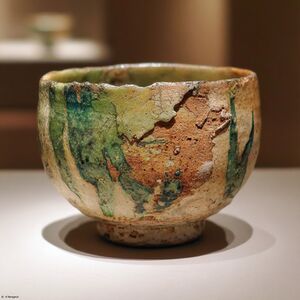Ki-Seto

Ki-Seto is a style of Japanese pottery originating in the Mino Province kilns (present-day Gifu Prefecture) during the late Momoyama period (late 16th century). It is one of the substyles associated with Seto ware and is distinguished by its warm yellow glaze.
History
Ki-Seto developed alongside other Mino styles such as Shino ware and Oribe ware, during a period of significant experimentation in Japanese ceramics. Its emergence is linked to the increased demand for distinctive tea ceremony utensils among the elite of the time.
The name Ki-Seto literally means “yellow Seto,” referring to both its color and its connection to the Seto ceramic tradition. The style is believed to have been influenced by Chinese celadon and Korean stoneware, yet it retained a distinctly Japanese aesthetic.
Characteristics
Ki-Seto is known for:
- Yellow feldspar glaze (黄瀬戸釉, Ki-Seto-yū), produced by iron-rich clay and feldspathic glaze.
- Subtle greenish or amber tones, depending on firing atmosphere.
- Incised or combed decoration under the glaze.
- Warm, earthy appeal, often paired with simple, functional forms.
- High-temperature reduction firing to achieve rich glaze depth.
Types
While Ki-Seto is generally unified by its glaze color, variations exist:
- Plain Ki-Seto – minimal decoration, focusing on glaze tone.
- Decorated Ki-Seto – features carved, incised, or stamped motifs under the glaze.
- Green-accented Ki-Seto – with partial copper glaze producing green patches.
Cultural significance
Ki-Seto became popular in the Japanese tea ceremony for its warm, understated beauty, embodying the refined rusticity of wabi-sabi. Its earthy tones provided a visual contrast to darker tea and complemented seasonal aesthetics.
Modern production
Ki-Seto continues to be produced in Gifu Prefecture, particularly in Tajimi and surrounding areas. Contemporary potters explore new shapes and glaze applications while preserving traditional techniques.
See also
External links
- Tajimi City official website (in Japanese)
- Tajimi Tourism Association (in Japanese)